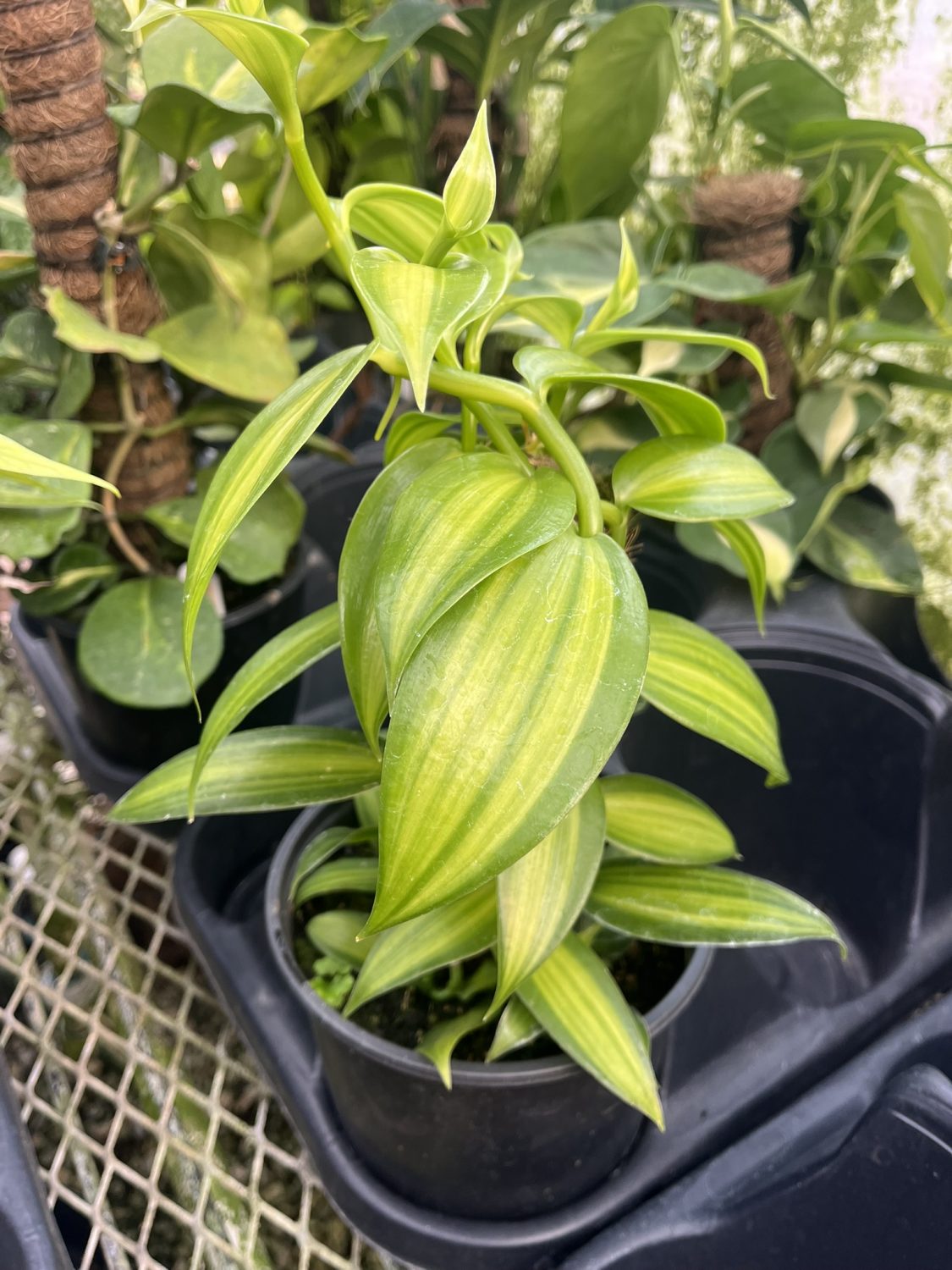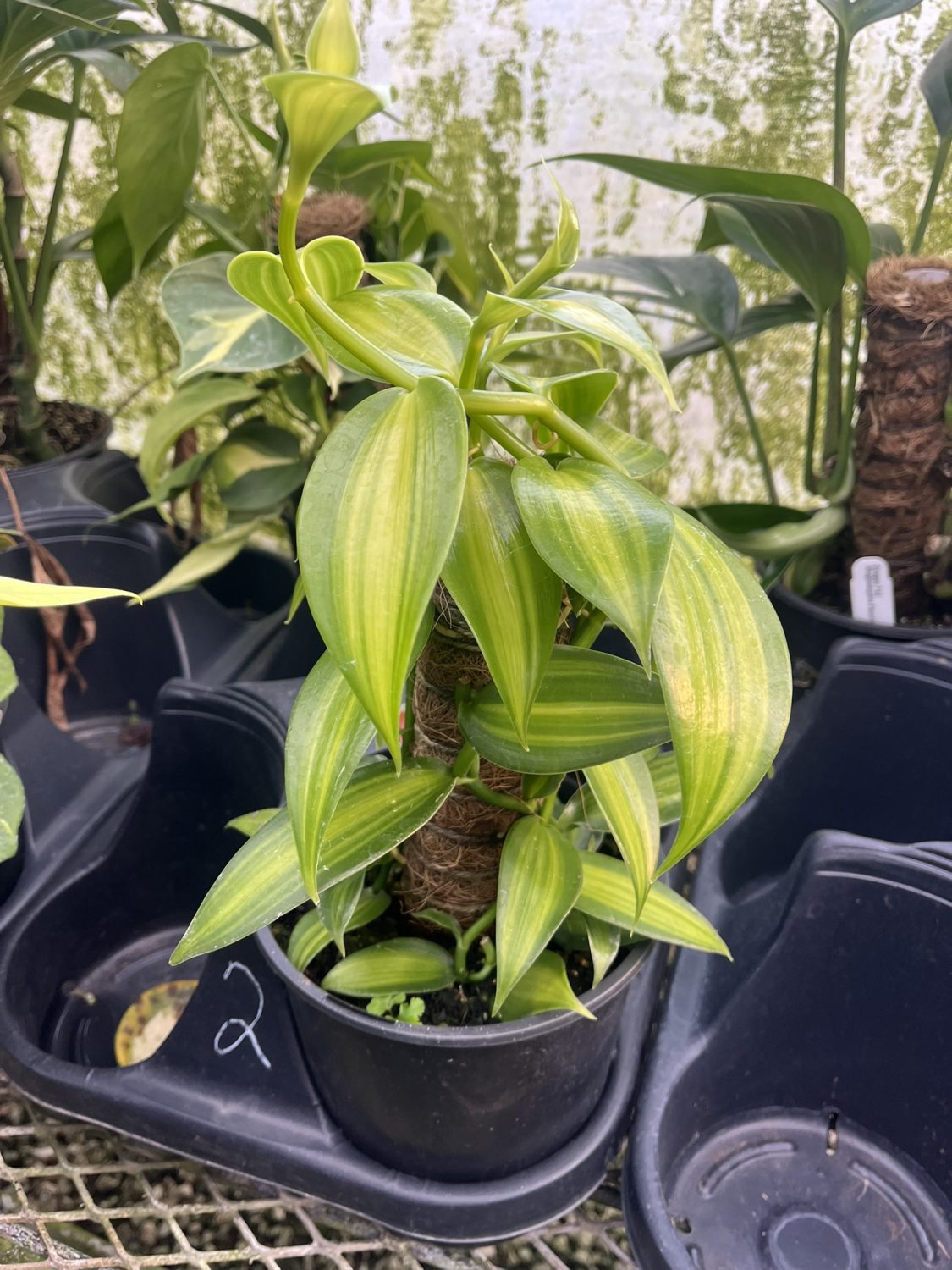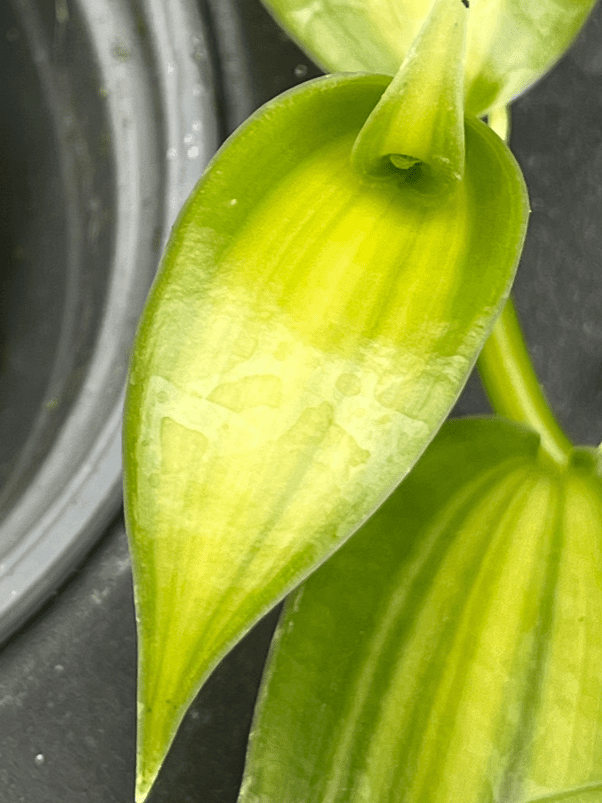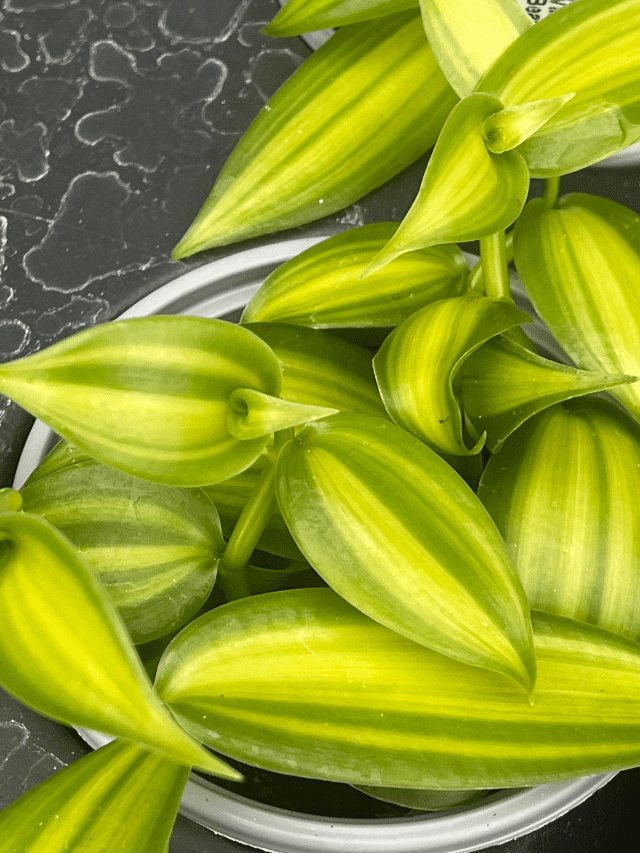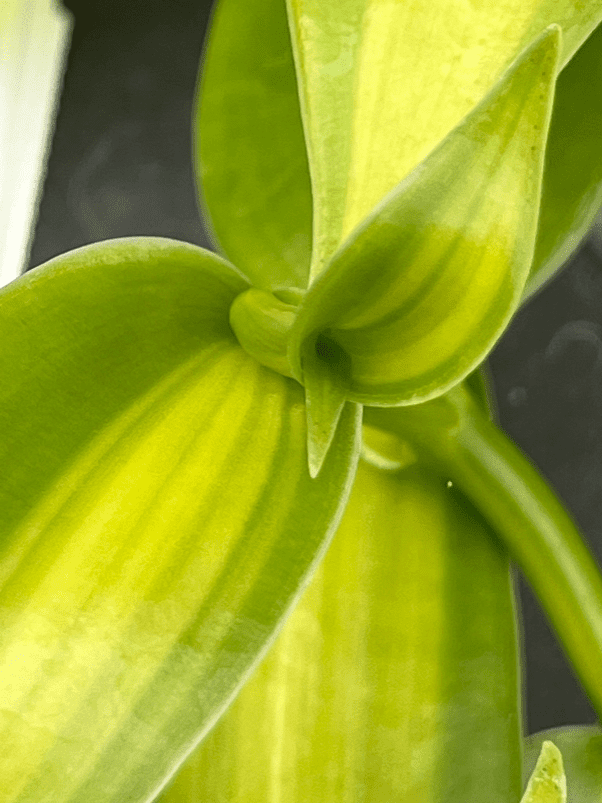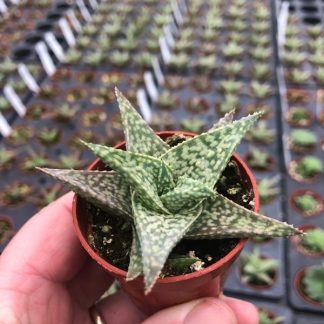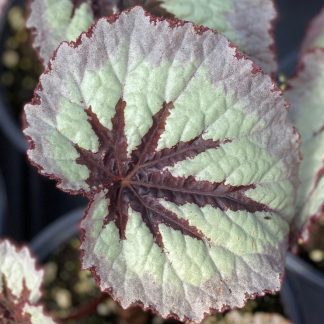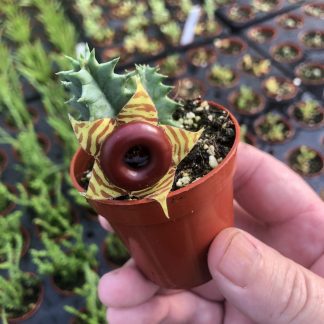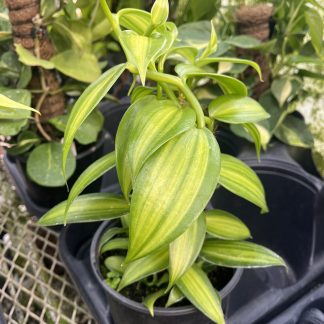Description
Vanilla planifolia ‘Variegata’ — The Striped Vanilla Orchid You’ll Love
Meet Vanilla planifolia ‘Variegata’, the famous vanilla orchid with creamy stripes that glow. It climbs. It curls. It charms. And yes, it can make real vanilla beans with a little help. In other words, this is a plant that brings beauty and flavor into one graceful vine. We get a lot of requests for this gem because it checks many boxes at once: striking foliage, easy routine, and a story your friends will want to hear.
Let’s walk through everything you need to know. We’ll keep it simple, clear, and fun—so you feel ready to grow your striped vanilla with confidence.
Why You’ll Want This Variegated Vanilla
Bold leaves with soft cream streaks. Each leaf shows different marbling, so no two vines look the same. The pattern pops in bright, indirect light. It reads fresh and clean in any room.
A living story. This vine is the source of the vanilla we use in kitchens. With warm temps and a steady hand, you can pollinate the flowers and grow pods. Instead of a short-lived bouquet, you get a plant that keeps giving.
Climbing habit, small footprint. Vanilla grows up, not out. It loves a stake, a moss pole, or a hoop. But most of all, it loves a simple spot where it can stretch.
Tropical look. Big glossy leaves bring that lush vibe. In other words, your space feels like a warm greenhouse, even on a gray day.
Plant Stats at a Glance
- Name: Vanilla planifolia ‘Variegata’
- Type: Climbing orchid (evergreen vine)
- Foliage: Green leaves with cream or yellow-white variegation
- Light: Bright, indirect; soft morning sun is welcome
- Water: Even moisture with light dry-down between drinks
- Humidity: Medium to high is best
- Temperature: Warm; aim for 65–85°F
- Mature Size: Vines can reach many feet with support
- Growth Habit: Nodes along the stem form roots on contact with a support or well-aerated media
- USDA Zones: Best outdoors year-round in very warm climates (typically 11–12); indoors everywhere else
Light: Bright but Gentle
Give your vanilla bright, indirect light. A few hours of soft morning sun is great. Midday sun can be harsh and may bleach the creamy areas first. If leaves turn pale or get crisp spots, pull back from the window or add a sheer curtain. Instead of full shade, choose a bright room with filtered light. You’ll see deeper green and stronger striping.
Tip: Rotate the pot once a week. This keeps the vine straight and spreads light evenly across the foliage.
Water: Even Rhythm, Happy Roots
Vanilla likes even moisture. Water when the top inch of your mix feels dry. Soak until water drains from the bottom. Then let it breathe. The roots also enjoy light misting, especially where they grip the pole. After more than a few weeks with steady watering, you’ll notice brighter, thicker leaves.
What to avoid:
- Constant sogginess. Roots need air.
- Bone-dry spells. Leaves may curl or wilt.
In other words, keep a simple rhythm: water well, drain well, then wait for the top to dry a bit.
Humidity and Temperature: Warm and Welcoming
Think tropical. 65–85°F is the sweet spot. Short dips below 60°F are okay, but growth slows. Humidity around 50–70% keeps leaves glossy and roots active along the pole. A room humidifier helps in winter. Grouping plants also raises the local humidity.
Quick check: If leaf tips brown or new roots stall, bump humidity and review your watering.
Potting Mix: Airy, Loose, and Rich
This orchid is a climber, not a standard “potted” plant. The roots want air. Use a chunky, well-draining mix such as:
- 1 part orchid bark (medium grade)
- 1 part coco chips or coarse perlite
- 1 part high-quality potting mix
- A handful of sphagnum moss blended in to hold gentle moisture
Press the mix softly around the root zone. Do not pack it tight. Air pockets help the vine breathe and grow faster.
Support: Give It Something to Hug
Vanilla shines when it climbs. Use a moss pole, a wood trellis, or even a looped hoop for a tidy shape. Tie the vine loosely with soft plant tape. As new nodes reach the support, they’ll send out roots and grip. Instead of fighting the climb, lean into it. You’ll get larger leaves and a cleaner look.
Feeding: Light but Regular
Use a balanced, gentle fertilizer during active growth. A half-strength feeding every 2–4 weeks in spring and summer works well. In fall and winter, feed less. If your plant grows indoors under bright lights all year, keep a mild, steady schedule.
Signs you’re on track: firm new leaves, steady node spacing, and a deep green base color under the cream streaks.
Blooming and Vanilla Pods (Yes, You Can!)
The vanilla orchid blooms on mature vines. Patience matters. With good care and a tall, well-rooted plant, you may see flower spikes on older sections. The blooms are short-lived—often open only for a day—so timing is key.
If you want pods, you’ll likely need hand pollination. Here’s the short version many growers use:
- Watch for open flowers in the morning.
- Gently lift the membrane that separates the anther and stigma.
- Move pollen onto the stigma with a small tool or toothpick.
- Be gentle and calm. One neat move beats a rush.
When pollination takes, a green bean-like pod begins to swell. After months it matures. Curing and drying pods for kitchen use is its own simple craft. But most of all, enjoy the process. It’s a special thing to grow your own vanilla.
Pruning and Propagation: Easy, Node by Node
Vanilla vines root at the nodes. This makes propagation very simple. Take a cutting with 2–3 nodes. Let the cut end dry for a day. Then lay it on moist sphagnum or nestle it into your airy mix against a support. Keep warm and slightly humid. New roots will grab on and push fresh growth.
Prune to shape after more than a few feet of growth. Snip just above a node. Use clean tools. New side shoots will branch and give you a fuller plant.
Common Issues and Simple Fixes
- Yellowing leaves: Often from overwatering or low light. Improve drainage. Move to brighter, indirect light.
- Brown tips: Dry air or inconsistent watering. Raise humidity and steady your schedule.
- Pale variegation fading: Too little light. Find a brighter spot with soft, filtered rays.
- Slow growth: Cool temps, tight mix, or not enough feed. Warm it up, loosen the mix, and use light fertilizer.
- Pests: Check leaf undersides and nodes for mealybugs or scale. Wipe leaves with a damp cloth. Treat early and repeat weekly until clear. Cleanliness is your best friend.
Styling Ideas You’ll Love
The tall totem. Train one vine up a moss pole for a sculptural look. It reads modern and neat.
The looped hoop. Wind the vine around a hoop for a living wreath. It fits shelves and small corners.
The trellis screen. Several vines on a slim trellis create a soft, plant “panel” behind a chair or sink.
Kitchen corner story. Place near a bright east window. Add a note card about its vanilla origin. Guests will ask. You’ll smile.
Indoor or Outdoor?
If you live in a tropical zone, this vine can thrive outdoors in bright shade. For most of us, indoors is best. A bright sunroom, an east window, or a room with strong grow lights will keep leaves bold and the variegation crisp. In summer, you can move it outside to a shaded patio to boost growth—just avoid harsh midday sun and bring it back in before nights dip below the mid-60s.
Pet and Family Notes
Vanilla orchids are generally regarded as non-toxic to people and pets. Still, keep all plants out of reach of curious nibblers. The vine is too special to chew, and you’ll protect those pretty leaves.
What You’ll Receive
You’ll get a healthy, well-rooted Vanilla planifolia ‘Variegata’ with active growth and fresh leaves. Each plant is unique, so variegation may vary slightly. That is part of the magic. Provide a support right away so the vine can climb and settle in fast.
Simple Care Summary (Pin This)
- Light: Bright, indirect; soft morning sun is ideal.
- Water: When top inch is dry; soak and drain.
- Humidity: 50–70% preferred.
- Temp: 65–85°F.
- Mix: Chunky and airy (bark + coco/perlite + potting mix + a touch of sphagnum).
- Support: Moss pole, trellis, or hoop.
- Feed: Half-strength, every 2–4 weeks in active growth.
- Prune/Prop: Cut above nodes; root cuttings easily.
- Pods: Hand pollinate morning blooms on mature vines.
Who This Plant Fits Best
- The collector who wants a rare, variegated twist on a classic species.
- The foodie who dreams of growing real vanilla pods at home.
- The stylist who loves tall, clean lines and a tropical glow.
- The beginner who wants a forgiving plant that teaches gentle routines.
Instead of choosing between pretty and practical, you get both.
Your Next Step
Set your pole. Mix your airy blend. Pick a bright, soft-lit spot. Then welcome your striped vanilla home. We’ll cheer you on as you grow, climb, and—one day—bloom.
Bright Finish, Sweet Stripes
Vanilla planifolia ‘Variegata’ is a calm, steady grower with a dazzling pattern. With simple care, it rewards us again and again. In other words, it’s a plant that loves our daily rhythm and makes any room feel warm. Bring one home, give it a place to climb, and enjoy the slow, sweet show.

